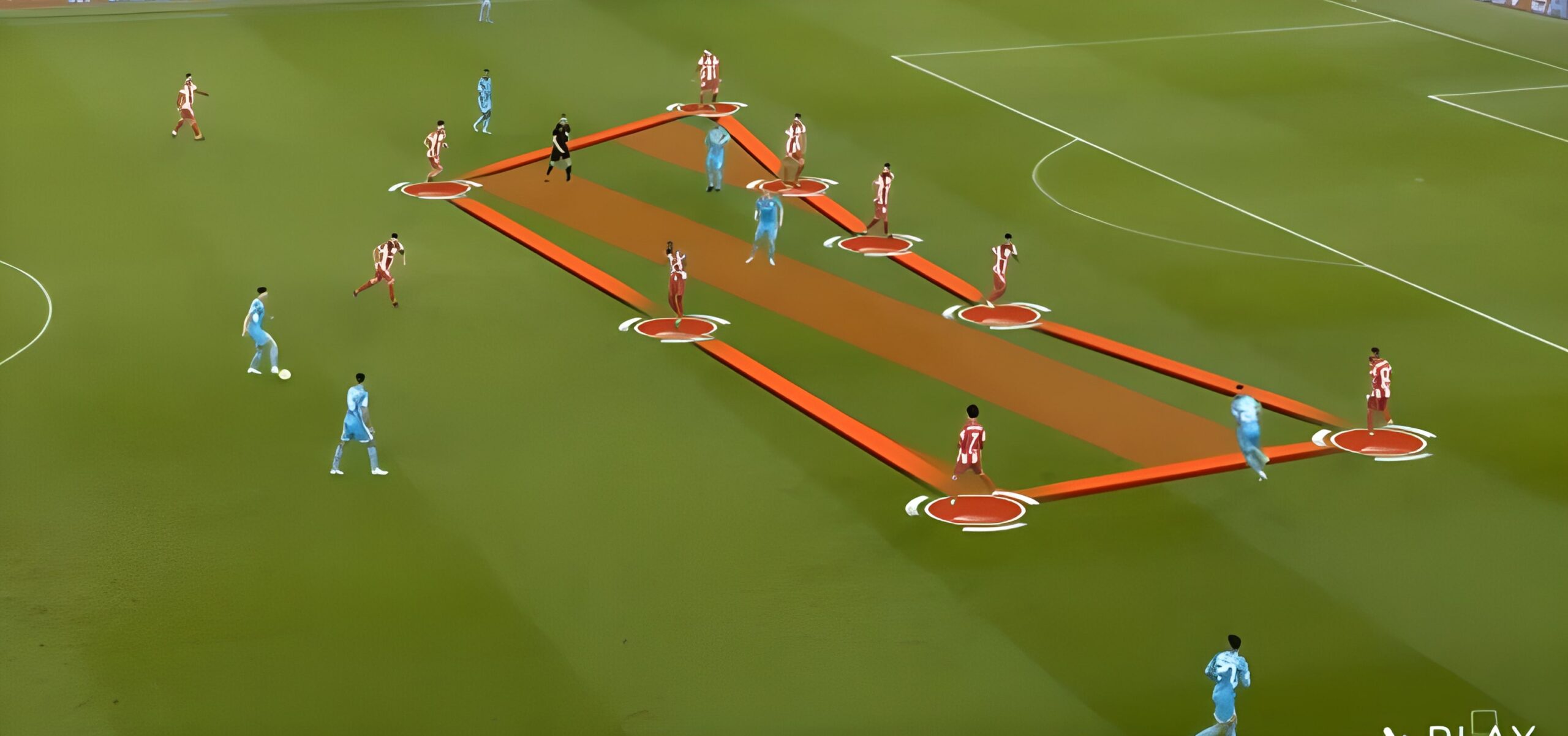
In modern football, more and more teams defend in low-blocks, or in other words they park the bus as José Mourinho used to say. Therefore, as a coach, knowing how to attack a low-block is key to ensure success in your team. Facing a low block can present a unique set of challenges for teams looking to break down their opponents. To navigate this situation successfully, it is essential to recognize the game context and employ both team and player principles. In this article, we delve into the key points on how to attack a low block, focusing on contextual awareness and team principles that can elevate your team’s performance on the field.
Game Context: Recognizing the Challenge
Understanding the dynamics of a low block is the first step toward overcoming it. So, what do we mean when we talk about teams attacking against in a low block? In these situations, teams often encounter a high-density defensive structure with limited spaces between lines. Additionally, there is very limited space behind the defensive line, making it challenging to exploit movements in the backline. Opponents are compact and ready to launch counterattacks swiftly, so aside from finding the solutions to break the defensive block it is important also to protect the team against potential counter-attacks.
So, let’s see 4 team principles that will help you attack against a low block.
“THE MAIN OBJECTIVE WHEN ATTACKING AGAINST A LOW-BLOCK IS TO USE THE FLANKS, GENERATING ADVANTAGES ON THE SIDES TO CROSS THE BALL INTO THE BOX, AND STRATEGICALLY AVOIDING COUNTERATTACKS.”

1
In this situation, Riyad Mahrez (Winger) provides the creation of width allowing the team to find him in an advantageous position to cross.

2
On the other hand, in this example from Liverpool FC it is Andrew Robertson (Full Back) who is responsible for providing width in attack.
Ball Circulation Strategies: Generating Collective Advantages
The second important point that you must consider when attacking a low-block is to have a good ball circulation. As we explain in this other article, Key Concepts For Good Ball Circulation, there are several types of ball circulation strategies and the team must master them all. Switching the ball’s orientation to find 1vs1 situations on the other flank, playing the ball out-in-out to stretch and contract the opposite block, using short-short-long passes, or playing forward-backward to then cross behind the opposite block are some ball circulation strategies that will help the team create clear chances when the opponent is defending in a low-block.
- Switch the ball orientation
- In-out ball movement
- Short-Short-Long / Attract + Play Long
- Play forward (inside the pocket) – back to cross behind the opposite block
In the example below, we can see how Bayern München draws the attention of the opponent block with one of the wingers in one flank who then switches the ball to the other flank for a 1vs1 situation with the opposite winger.

3
Kingsley Coman (Bayern Munich) draws the attention of the opponent block, which shifts and becomes more compact in width, and then switches the game to the other side.

4
On the other flank, Sané (Right Winger), receives in a 1vs1 situation, with teammates making movements to avoid the coverage. This allows Bayern München to cross the ball to the box.
Generate advantages on the flanks
When attacking against low-blocks, it is very important to generate advantages on the flanks to be able to cross the ball with time and precision. These advantages on the flanks can be created in many ways: Positional, qualitative or numerical. It can be a positional advantage by playing towards a player who is able to surpass using a first-touch and then cross to the box, qualitative when we are able to find the players who have the best dribbling abilities in our team, or numerical when we are able to create situations 2vs1 situations on the flank. Creating these situations will help the team generate advantage on the flanks and cross the ball in favourable situations for the strikers and other players who are attacking the box.
- Positional
- Qualitative
- Numerical
In the following example, we can see how Nathan Aké (Full Back) from Manchester City that generates space forcing the opponent to react, giving Bernardo Silva the opportunity to prepare and execute a good cross.

5
Nathan Aké (Full Back), makes a run in the inner channel followed by his marker and dragging also some attention from the player defending Bernardo Silva.

5
Thanks to Aké's movement, Bernardo Silva gets some space and time to prepare and execute a good cross.
Maximize the options to score and control the counter-attacks
Finally, let’s talk about how the team must behave in the moment that the cross is made, both to maximize the chances of scoring and also to minimize the chances of conceding a counter-attack. For the first matter, it is very important that we occupy the box with at least 3 players. Many teams, such as Bayern München or FC Barcelona Femení occupy the box with up to 5 players in many occasions. Linked to this idea, it is important that these players are placed in a position from where they can attack the gaps between defenders. So, it is better to arrive to the target area when the ball is in the air than to wait for the ball already in that position.
Not less important it is how the team occupies the spaces outside the box for a potential rejection and how we mark the opposite strikers who are not defending the action. These two details will dictate the success than any potential counter-attack from the opponent will have. Failing to ensure these principles will cause the team to be very exposed, with big spaces behind their defensive line.
- Minimum of 3 players attacking the box
- Attack gaps vs being in the place
- Get second balls
- Mark players can start the counterattack
In the last examples, we can see how Bayern München players are occupying the opponent’s box with 4 players ready to attack the cross while Manchester City is occupying the second ball zone with players ready to win any potential deflection.

7
In this situation, Bayer Munich's players are occupying the rival's box with 4 players

8
Manchester City players are ready to get a second ball
Conclusion
Attacking against a good low block requires a comprehensive approach that integrates recognizing the game context, having a good team structure, effectively applying different ball circulation strategies, and attacking the box with a minimum of players while ensuring the second balls zones and marking potential link players. By implementing these key principles, your team will be better prepared to overcome the challenges presented by opponents defending in a low block, as well as being more protected against potential counter-attacks.
Learn more about ‘How to Attack a Low-Block’ in our webinar. Watch here.
